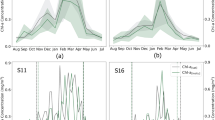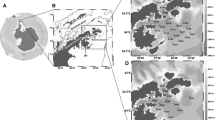Abstract
Oceanographic cruises have been conducted on the Condor seamount (SW Faial Island, Azores archipelago, NE Atlantic) since 2009 to collect in situ data and understand potential seamount effects on local biodiversity. Satellite data have been concurrently collected to infer the space-time upper-ocean optical property variability and the associated physical processes. The main limitation of this analysis is the persistent and significant cloud coverage above the region that, especially in some seasons, can significantly hinder satellite data availability. This study was meant to test the robust satellite technique (RST) over the Condor seamount, assess its capability to estimate multiyear trends and identify space-time anomalies. To this aim, 11-year MODIS/AQUA level 2-derived chlorophyll-a (chl-a) data were used. Results achieved for October 2010 show, within a large-scale analysis, the presence of well-defined areas of near-surface chl-a anomalies, highlighting the occurrence of a trapping effect due to flow-topography interaction processes. Regarding the Condor area, the chl-a anomalies detected along the eastern side of the seamount were linked to a strong vertical mixing that provided sufficient inorganic nutrients requested for productivity. The achieved results, whose accuracy was also tested through a comparison with in situ data, are consistent with those independently obtained by other authors who described the phytoplankton variability around the Condor seamount. This study shows the high potential of the RST approach to assess the chl-a variability in the space-time domain in oligotrophic regions such as the Azores, allowing the identification of the most important areas to be preserved and/or managed.













Similar content being viewed by others
References
Aristegui J, Mendonça A, Vilas JC, Espino M, Polo I, Montero MF (2009) Plankton metabolic balance at two North Atlantic seamounts. Deep-Sea Res II 56:2646–2655
Bashmachnikov I, Belonenko TV, Koldunov AV (2013b) Intra-annual and interannual non-stationary cycles of chlorophyll concentration in the Northeast Atlantic. Remote Sens Environ 137:55–68
Bashmachnikov I, Lafon V, Martins A (2004) SST distribution in the Azores region. Part II: space-time variability and the underlying mechanisms. Arquipelago: Life and Marine Sciences 21A:19–32
Bashmachnikov I, Loureiro CM, Martins A (2013a) Topographically induced circulation patterns and mixing over Condor seamount. Deep-Sea Res II Top Stud Oceanogr 98:38–51
Beckmann A, Mohn C (2002) The upper ocean circulation at Great Meteor Seamount. Ocean Dyn 52(4):194–204
Carmo V, Santos M, Menezes GM, Lourerio CM, Lombardi P, Martins A (2013) Variability of zoo plankton communities at Condor seamount and surrounding areas, Azores (NE Atlantic). Deep-Sea Res II 98:63–74
Chapman DC, Haidvogel DB (1992) Formation of Taylor caps over a tall isolated seamount in a stratified ocean. Geophys Astrophys Fluid Dyn 64(1–4):31–65
Comeau LA, Vézina AF, Bourgeois M, Juniper SK (1995) Relationship between phytoplankton production and the physical structure of the water column near Cobb Seamount, northeast Pacific. Deep-Sea Res I Oceanogr Res Pap 42(6):993–1005
Conselho da União Europeia (2002) Regulamento 2371/2002 relativo à conservação e à exploração sustentável dos recursos haliêuticos no âmbito da Política Comum das Pescas. Available on line at: http://eur-lex.europa.eu/legal-content/PT/TXT/?uri=CELEX:52012PC0277
Cushing DH (1989) A difference in structure between ecosystems in strongly stratified waters and in those that are only weakly stratified. J Plankton Res 11(1):1–13
de Boyer Montégut C, Madec G, Fischer AS, Lazar A, Iudicone D (2004) Mixed layer depth over the global ocean: an examination of profile data and a profile-based climatology. J Geophys Res Oceans 109(C12):C12003
Dower J, Freeland H, Juniper K (1992) A strong biological response to oceanic flow past Cobb Seamount. Deep Sea Res Part A 39(7):1139–1145
Franz BA, Kwiatowska EJ, Meister G, McClain CR (2008) Moderate resolution imaging spectroradiometer on Terra: limitations for ocean color applications. J Appl Remote Sens 2(1):023525–023525
Freelamd H (1994) Ocean circulation at and near Cobb Seamount. Deep-Sea Res I Oceanogr Res Pap 41(11):1715–1732
Genin A (2004) Bio-physical coupling in the formation of zooplankton and fish aggregations over abrupt topographies. J Mar Syst 50(1):3–20
Genin A, Boehlert GW (1985) Dynamics of temperature and chlorophyll structures above a seamount: an oceanic experiment. J Mar Res 43(4):907–924
Grimaldi CSL, Coviello I, Lacava T, Pergola N, Tramutoli V (2011) A new RST-based approach for continuous oil spill detection in TIR range: the case of the deepwater horizon platform in the Gulf of Mexico. Monitoring and modeling the deepwater horizon oil spill: a record-breaking enterprise, Geophysical Monograph Series, vol. 195, 271 pages, hardbound, ISBN 978-0-87590-485-6, AGU Code GM1954856, edited by Y. Liu et al., pp. 19–31, AGU, Washington, D. C., doi:10.1029/2011GM001105
Henson SA, Dunne JP, Sarmiento JL (2009) Decadal variability in North Atlantic phytoplankton blooms. J Geophys Res 114:C04013. doi:10.1029/2008JC005139.
Hooker S (2003) Algorithm updates for the fourth SeaWiFS data reprocessing. NASA Tech Memo 22 :2003–206892Available online at: http://oceancolor.gsfc.nasa.gov/SeaWiFS/TECH_REPORTS/PLVol22.pdf
Hu C, Lee Z, Franz B (2012) Chlorophyll a algorithms for oligotrophic oceans: a novel approach based on three-band reflectance difference. J Geophys Res Oceans (1978–2012) 117(C1):C01011
Hubbs CL (1959) Initial discoveries of fish faunas on seamounts and offshore banks in the eastern Pacific. Pac Sci 12:311–316
Lafon V, Martins A, Figueiredo M, Melo Rodrigues MA, Bashmachnikov I, Mendonca A, Macedo L, Goulart N (2004) Sea surface temperature distribution in the Azores region. Part I: AVHRR imagery and in situ data processing. Arquipélago: Life and Marine Sciences 21A:1–18
Lourenço N, Miranda JM, Luís JF, Ribeiro A, Mendes Victor LA, Madeira J, Needham HD (1998) Morpho-tectonic analysis of the Azores volcanic plateau from a new bathymetric compilation of the area. Mar Geophys Res 20:141–156
Lyapustin A, Wang Y, Xiong X, Meister G, Platnick S, Levy R, et al. (2014) Scientific impact of MODIS C5 calibration degradation and C6+ improvements. Atmos Meas Tech 7:4353–4365. doi:10.5194/amt-7-4353-2014
Margalef R (1958) Temporal succession and spatial heterogeneity in phytoplankton. In: Buzzati-Traverso AA (ed) Perspective in marine biology. University of California Press, Berkeley, pp. 323–349
Mendonça A, Arístegui J, Vilas JC, Montero MF, Ojeda A, Espino M, Martins A (2012) Is there a seamount effect on microbial community structure and biomass? The case study of Seine and Sedlo Seamounts (Northeast Atlantic). PLoS One 7(1):e29526
Mendonça A, Martins A, Figueiredo M, Bashmachnikov I, Couto A, Lafon V, Aristegui J (2010) Evaluation of ocean color and sea surface temperature sensors algorithms using in situ data: a case study of temporal and spatial variability on two northeast Atlantic seamounts. J Appl Remote Sens 4(1):043506–043506
Morato T, Machete M, Kitchingman A, Tempera F, Lai S, Menezes G, Santos RS (2008) Abundance and distribution of seamounts in the Azores. Mar Ecol Prog Ser 357:17
Morato T, Cheung WW, Pitcher TJ (2006) Vulnerability of seamount fish to fishing: fuzzy analysis of life-history attributes. J Fish Biol 68(1):209–221
Mourino B, Fernández E, Serret P, Harbour D, Sinha B, Pingree R (2001) Variability and seasonality of physical and biological fields at the great meteor Tablemount (subtropical NE Atlantic). Oceanol Acta 24(2):167–185
Mullineaux LS, Mills SW (1997) A test of the larval retention hypothesis in seamount-generated flows. Deep-Sea Res I Oceanogr Res Pap 44(5):745–770
O’Reilly JE, Maritorena S, Mitchell BG, Siegel DA, Carder KL, Garver SA, et al. (1998) Ocean color chlorophyll algorithms for SeaWiFS. J Geophys Res Oceans 103(C11):24937–24953
Odate T, Furuya K (1998) Well-developed subsurface chlorophyll maximum near Komahashi No. 2 Seamount in the summer of 1991. Deep-Sea Res I Oceanogr Res Pap 45(10):1595–1607
Pham CK, Gomes-Pereira JN, Isidro EJ, Santos RS, Morato T (2013) Abundance of litter on Condor seamount (Azores, Portugal, Northeast Atlantic). Deep-Sea Res II Top Stud Oceanogr 98:204–208
Quartau R, Tempera F, Mitchell NC, Pinheiro LM, Duarte H, Brito PO, Bates CR, Monteiro JH (2012) Morphology of the Faial Island shelf, Azores: the interplay between volcanic, erosional, depositional, tectonic and mass-wasting processes. Geochem Geophys Geosyst 13(4):1–30
Rémillard J, Kollias P, Luke E, Wood R (2012) Marine boundary layer cloud observations in the Azores. J Clim 25(21):7381–7398. doi:10.1175/JCLI-D-11-00610.1
Roden GI (1987) Effect of seamounts and seamount chains on ocean circulation and thermohaline structure. Seamounts, islands, and atolls, 335–354
Rowden AA, Dower JF, Schlacher TA, Consalvey M, Clark MR (2010) Paradigms in seamount ecology: fact, fiction and future. Mar Ecol 31(s1):226–241
Samadi S, Bottan L, Macpherson E, De Forges BR, Boisselier MC (2006) Seamount endemism questioned by the geographic distribution and population genetic structure of marine invertebrates. Mar Biol 149(6):1463–1475
Santos M, Moita MT, Bashmachnikov I, Menezes GM, Carmo V, Loureiro CM, Mendonça A, Silva AF, Martins A (2013) Phytoplankton variability and oceanographic conditions at Condor seamount, Azores (NE Atlantic). Deep-Sea Res II 98(Part A):52–62
Santos R, Hawkins S, Monteiro LR, Alves M, Isidro EJ (1995) Marine research, resources and conservation in the Azores. Aquat Conserv Mar Freshwat Ecosyst 5(4):311–354
Siegel DA, Doney SC, Yoder JA (2002) The North Atlantic spring phytoplankton bloom and Sverdrup’s critical depth hypothesis. Science 296:730–733. doi:10.1126/science.1069174.
SPI Açores (2014) Estratégia de Investigação e Inovação para a Especialização Inteligente da Região Autónoma dos Açores – RIS3, PR-01997, 137 pp
Stewart RH (2008) Introduction to physical oceanography (e-book). Texas A & M University, available online at http://oceanworld.tamu.edu/home/course_book.htm
Tokarev YN, Bityukov EP, Williams R (2003) Influence of seamounts at the Atlantic Ocean on modification of the bioluminescence and plankton characteristics. Mar Ecol J 2:46–58
Tramutoli V (2007) Robust satellite techniques (RST) for natural and environmental hazards monitoring and mitigation: theory and applications. Fourth International Workshop on the Analysis of Multitemporal Remote Sensing Images (Multitemp 22007). doi: 10.1109/MULTITEMP.2007.4293057
Ueyama R, Monger BC (2005) Wind-induced modulation of seasonal phytoplankton blooms in the North Atlantic derived from satellite observations. Limnol Oceanogr 50(6):1820–1829
Vilas JC, Arístegui J, Kiriakoulakis K, Wolf GA, Espino M, et al. (2009) Seamounts and organic matter-is there an effect? The case of Sedlo and Seine seamounts. Part1. Distributions of dissolved and particulate organic matter. Deep-Sea Res II Top Stud Oceanogr 56:2618–2630
White M, Bashmachnikov I, Arístegui J, Martins A (2007) Physical processes and seamount productivity. In: Pitcher TJ, Morato T, Hart PJB, Clark MR, Haggan N, Santos RS (eds) Seamounts: ecology, conservation and management. Fish and aquatic resources series, 12. Blackwell Publishing, Oxford, pp. 65–84
Worm B, Lotze HK, Myers RA (2003) Predator diversity hotspots in the blue ocean. Proc Natl Acad Sci 100(17):9884–9888
Acknowledgments
We would like to strongly acknowledge the scientific and technical staff of the Oceanography Section in the Department of Oceanography and Fisheries of the University of the Azores (DOP/UAç), as well as the captain, crew and scientific staff at R/V “Arquipélago” for the assistance in collecting the in situ oceanographic data.
The results of the work were partially obtained under the CONDOR project (PT0040), supported by the EEA grants Iceland, Liechtenstein and Norway and under the CIMBA project, supported by the Regional Directory for Science and Technology. We would also like to thank the Ph.D. FRCT Fellowship Grant reference: M3.1.2/F/063/2011 for Clara Loureiro.
This work was performed during the staying of Dr. Emanuele Ciancia at Department of Oceanography and Fisheries of the University of the Azores (DOP/UAç) as Ph.D. visiting researcher, in the framework of the OP-ERDF IOSMOS (IOnian Sea water quality MOnitoring by Satellite data) project, co-funded by Basilicata Region in collaboration with the Institute of Methodologies for Environmental Analysis, the University of Basilicata, and the Technological Educational Institute of Crete.
Author information
Authors and Affiliations
Corresponding author
Additional information
Responsible Editor: Yajing Yan
This article is part of the Topical Collection on the 47th International Liège Colloquium on Ocean Dynamics, Liège, Belgium, 4–8 May 2015
Rights and permissions
About this article
Cite this article
Ciancia, E., Magalhães Loureiro, C., Mendonça, A. et al. On the potential of an RST-based analysis of the MODIS-derived chl-a product over Condor seamount and surrounding areas (Azores, NE Atlantic). Ocean Dynamics 66, 1165–1180 (2016). https://doi.org/10.1007/s10236-016-0972-9
Received:
Accepted:
Published:
Issue Date:
DOI: https://doi.org/10.1007/s10236-016-0972-9




